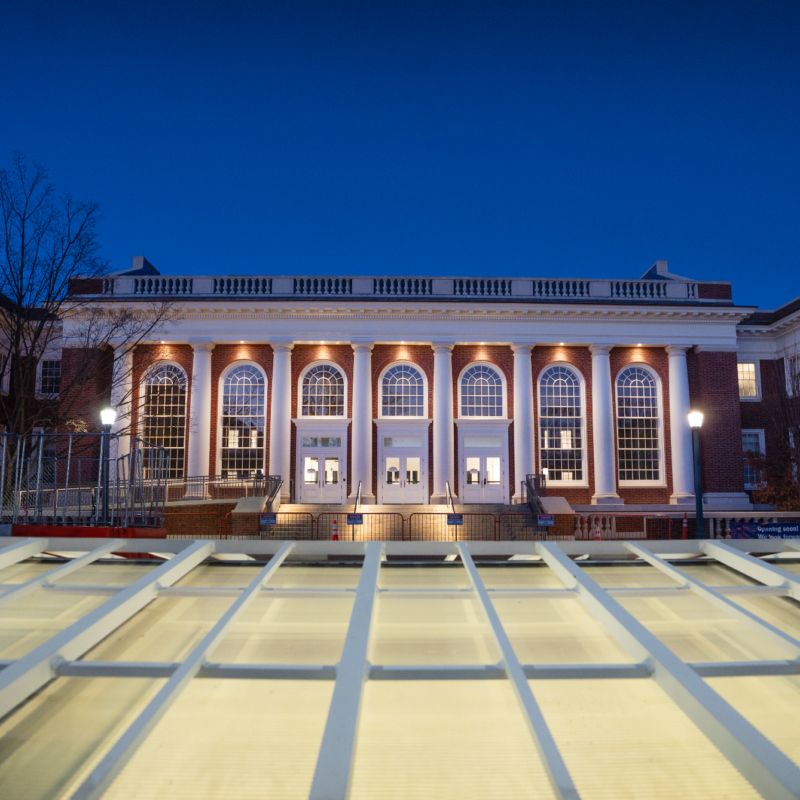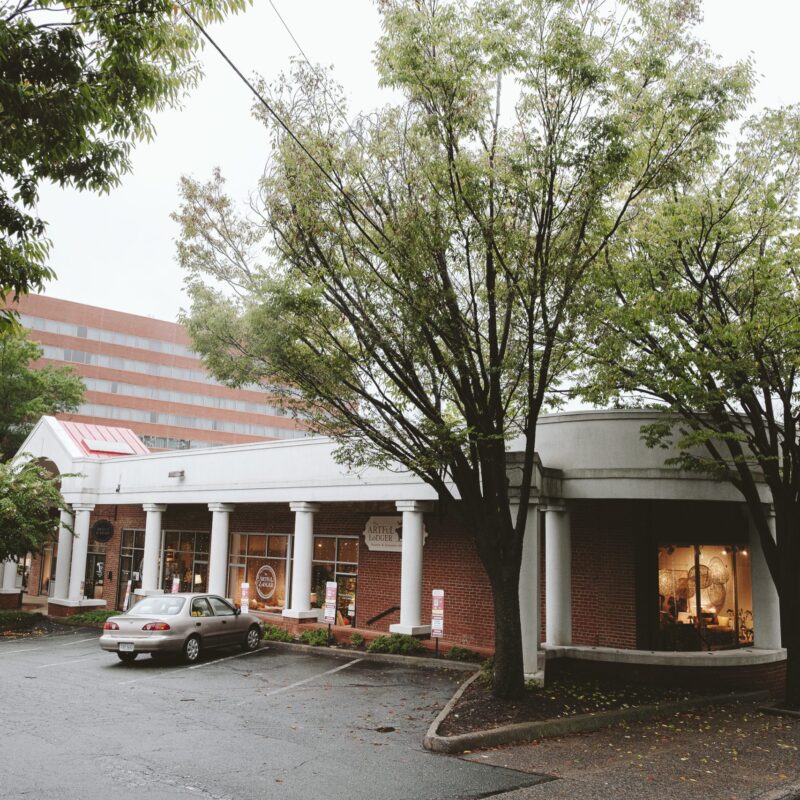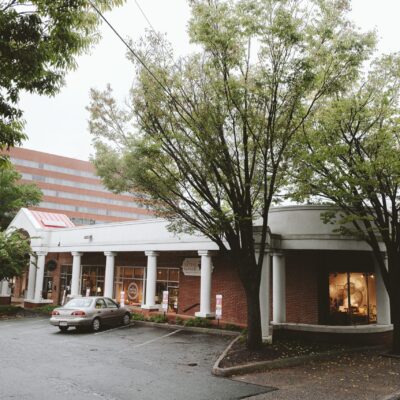You don’t need to have lived in the area your whole life to see the design flaws in Route 29N—all it takes is a 5pm trip to Wal-Mart or Whole Foods to experience the magic. But while it’s easy enough to see the traffic problems, it might take a philosopher king to ordain a solution, despite decades of community discussion. Recent conflict over a modest report on building an overpass, or “split-grade intersection,” at Rio Road and Route 29 reveals a microcosm of the difficulties moving forward on 29N.
 Places29 projects that current shopping centers like Albemarle Square can blossom in coming decades—but such changes will probably require major road work, like building a split-grade interchange at Rio Road. |
Before we get to the report, some groundwork for those who haven’t memorized local traffic counts. However fancy the term may sound, split-grade intersections are just overpasses where one road goes over another—they’re part of the main reason that interstates are so damn fast, since you don’t have to stop every time you come to a road crossing. You use split-grade intersections everyday if you travel on I-64 or the Route 250 Bypass.
Analysts have long pegged split-grade intersections as major keys to improving traffic flow along Route 29, 90 percent of which is local. It’s little surprise that they are recommended for Hydraulic and Rio roads by the Places29 Master Plan, a $1 million plus study to figure out what the hell to do with the roads and the land in the area’s extended strip mall.
But so far, the Places29 consultants haven’t released cost estimates for the major transportation improvements, like the split-grade interchanges. Harrison Rue, the executive director of the Thomas Jefferson District Planning Commission and coordinator for Places29, says that the cost estimates should be ready in a month, as part of a report to the Albemarle County Planning Commission.
The Free Enterprise Forum, a pro-business organization impatient for those cost estimates, paid Jack Hodge, a Virginia Department of Transportation engineer-turned-private consultant, $5,000 to write an analysis of costs for the split-grade interchanges. Hodge said that doing a complete cost estimate would take $200,000, but he managed to put together a five-page memo [pdf] speculating on the costs of building an interchange at Rio Road and Route 29. His crude estimate: between $38 million and $56 million, a figure that excludes right-of-way acquisition.
Though some quibble with Hodge’s methodology, those numbers aren’t shocking for a project of its scale. What stirred up some interchange advocates instead was the way that Neil Williamson, director of the Free Enterprise Forum, publicized some of Hodge’s other analysis. Williamson latched on to Hodge’s analysis that the interchange could hinge on getting state and federal approvals for detour routes during construction.
“That was really the ‘aha’ moment to me,” says Williamson. “The other things were of interest, but the concept that it might not be able to be built at all was troubling.”
Williamson said in a press release about the report that, “Former VDOT Chief Engineer, Jack Hodge, has determined the Federal Highway Administration (FHA) will not allow the construction of the Rio/US 29 interchange.”
That would be big stuff—imagine the headlines, “Lynchpin of 29N plan unbuildable”—except that it’s not entirely accurate.
“I find it to be completely disingenuous,” says county Supervisor Dennis Rooker. “I think that they’ve taken great liberties with the conclusions based in that letter.”
What Hodge actually says is more nuanced than Williamson’s press release suggests. Hodge says that the FHA wouldn’t approve a specific detour of 29 along the parallel road network. Translating that further from VDOT talk, in order to build the overpass, you’ve got to figure out how to keep traffic flowing around it, which might involve some expensive temporary overpasses.
“The FHA won’t necessary prevent it, but they will likely lay down a rocky road in front of it,” says Hodge. When he was chief engineer of VDOT, Hodge supported building the Western Bypass, a project now all but dead after it was blocked by environmental concerns and a lack of local support. He says that detouring would be quite expensive and would have a “monumental impact.”
FHA will not comment on the project because it has received no official notice from the state of Virginia.
“The reality of this report is there is no new news there,” says Rue, who points out that Hodge did not contact the Places29 team for information. “This is normal standard operating procedure. We have actually had several workshops with the local business community to discuss the construction of the intersection.” Williamson attended one such workshop, but says he thought many important questions remained unanswered.
Such technical discussion can obfuscate what’s at the heart of the matter. Much of the concern about the intersections stems not from whether the things can ever get built, but what they will do to businesses while construction is going on. Williamson points to another FEF study that calculates the Route 29N corridor generated $33 million in tax revenue for the city and county in 2006.
The North Charlottesville Business Council (NCBC), a branch of the local Chamber of Commerce, has fears about what split-grade interchanges at Rio and Hydraulic roads would do to business by changing which business locations are easily visible and accessible to customers.
“NCBC has raised serious doubts about the do-ability of a work zone that goes on for 10 or 20 years along the commercial main street,” says Timothy Hulbert, president of the Chamber.
Rooker doesn’t dispute 29N’s significance to the local economy. “It is an important part of the tax base for Albemarle and Charlottesville,” he says. “The needs of the businesses need to be worked with. But I’m not convinced that the intersections would have any long-term negative effect on businesses there. I think that failure to move ahead would have a negative long-term impact on businesses. Most people tend to stay away from places where the traffic doesn’t move.”
“It’s very hard in the abstract to argue with any design that promises to drastically alter an area,” says Hulbert. “It’s in all likelihood true. But you need to tread very carefully when you’re talking about massive economic dislocation.”
He points to the Downtown Mall as an example: By opting to brick over Main Street, the city dramatically altered the economic landscape, the change eventually pushing most businesses out and encouraging a much different collection to set up shop. Hulbert is concerned about current 29N businesses getting lost in the “creative destruction” that split-grade intersections would bring.
Rooker points out that businesses opposed the widening of 29N in the ’90s. “Where would we be today if we didn’t widen 29? There’s always an opposition to change of any kind.
“The fact is that interchanges are built all over the country in all kinds of circumstances,” Rooker says. “For some reason, there’s this effort to make grade-separated interchanges look like they were UFOs. We have one at Locust Avenue, at Diary Road. Where would we be to today with the 250 Bypass if we didn’t have interchanges?”
Regardless of the cost, it remains to be seen how major highway projects such as the interchanges can be financed. Local transportation funding is expected to fall 44 percent next year. Richmond has continuously scaled back funding over the years, and last year’s state transportation funding plan fell apart and all the governor’s men have yet to put it together again.
So enjoy the holding pattern on Route 29—we could be in for a very long wait.
C-VILLE welcomes news tips from readers. Send them to news@c-ville.com.





